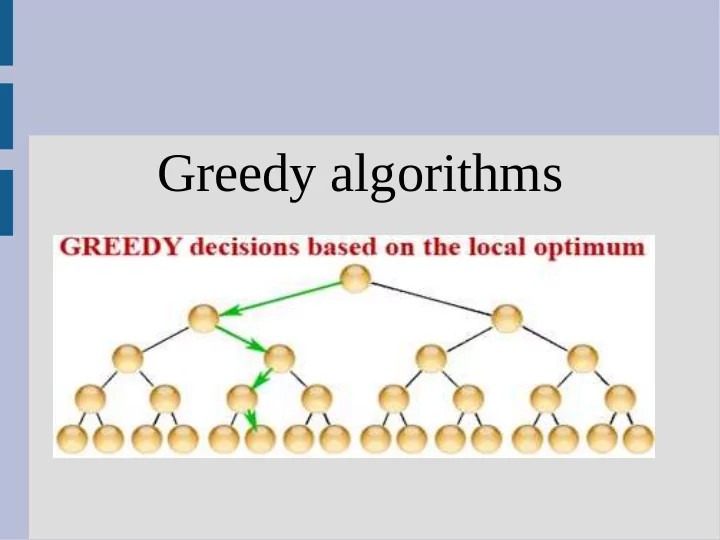

Greedy algorithms
Greedy algorithms Find the best solution to a local problem and (hope) it solves the global problem
Greedy algorithm Greedy algorithms find the global maximum when: 1. optimal substructure – optimal solution to a subproblem is a optimal solution to global problem 2. greedy choices are optimal solutions to subproblems
Activity selection A list of tasks with start/finish times Want to finish most number of tasks
Activity selection Optimal substructure: Finding the largest number of tasks that finish before time t can be combined with the largest number of tasks that start after time t
Activity selection Greedy choice: The task that finishes first is in a optimal solution Proof: Suppose we have optimal solution A. If quickest finishing task in A, done. Otherwise we can swap it in.
Activity selection Greedy: select earliest finish time
Knapsack problem A list of items with their values, but your knapsack has a weight limit Goal: put as much value as you can in your knapsack
Knapsack problem What is greedy choice?
Knapsack problem What is greedy choice? A: pick the item with highest value to weight ratio (value/weight) (only optimal if fractions allowed)
Huffman code Who has used a zip/7z/rar/tar.gz? Compression looks at the specific files you want to compress and comes up with a more efficient binary representation
Huffman code How many letters in alphabet? How many binary digits do we need? If we are given a specific set of letters, we can have variable length representations and save space: aaabaaabaa : a=0,b=1->0001000100 or :aaab=1,a=0 -> 1100
Huffman code Huffman code uses variable size letter representation compress binary representation on a specific file letter: a b c d e count: 15 7 6 6 5 What is greedy choice?
Huffman code We want longer representations for less frequently used letters Greedy choice: Find least frequently used letters (or group of letters) and assign them an extra 1/0 Repeat until all letters unique encode
Huffman code 1. Merge least frequently used nodes into a single node (usage is sum) 2. Repeat until all nodes on a tree
Huffman code Huffman coding length = 15 * 1 + 3 * 24 = 87 Original coding length = 15 * 3 + 3 * 24 = 117 25 percent compression
Dynamic programming Greedy algorithms are closely related to dynamic programming (You will learn this in CSci 5421) Idea: “forward” solution hard, so start from end (subproblem) and recombine to get start
Dynamic programming Shortest path from A to D? (Can start/end on x or y)
Recommend
More recommend